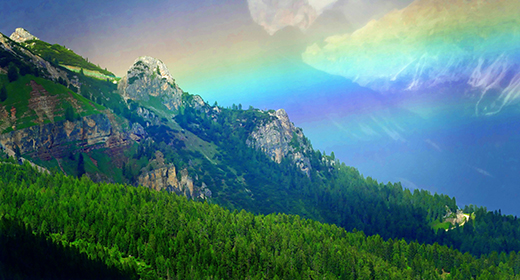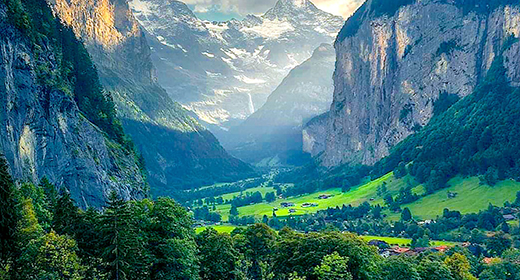by Chad Foreman: When I discovered this meditation system while living at a Tibetan Buddhist centre it changed everything for me…

At the time I was engaged in all sorts of spiritual Tibetan Buddhist practices including making prostrations to Buddhas, reciting daily prayers and making imaginary offerings to gurus, attending complicated philosophical teachings and meditating on intricate visualisations of deities. So when I discovered a complete path to enlightenment which only included what I considered actual meditation, I was very excited to start straight away.
In fact this meditation system claimed you didn’t even need to be a Buddhist to gain the incredible results and it stands by itself as a complete system to enlightenment, so it was controversial to say the least for the Buddhist establishment when it emerged in the 14th century. It makes total sense to me and it was something that you could experience for yourself that required no beliefs and relied primarily on your own efforts.
The system is called Mahamudra and it comes from the Kagyu tradition of Tibetan Buddhism and is known as the practice lineage which focuses predominantly on engaging in meditation rather than study or rituals; stripping everything down to the bare essentials. It’s especially concerned with resting in the nature of your own mind.
I didn’t know it at the time but this meditation system was the inspiration for what I now call The Way of Meditation which has since encouraged and helped hundreds of thousands of people around the world to start meditating and to deepen their practice. However I do not claim to be a Tibetan Buddhist teacher I have translated everything and adapted it to suit my own needs and modified it to appeal to the needs of a modern secular audience.
The first stage is to stabilise your attention through mindfulness meditation focussed on a particular object like the breath. This helps to overcome distraction, calm the mind and assists in the ability to control your own attention. The second stage is broadening that mindful awareness to include more and more of the present moment, and develop the flexibility to focus on what you want to focus on, again without distraction. Next is turning inward to investigate the nature of the awareness itself and lastly it’s learning to rest naturally in the nature of mind you have discovered through the direct experience of investigation.
The Four Stages Of Meditation From Mindfulness To Mysticism
1. Mindfulness With An Object
Mindfulness is a huge movement these days especially useful for: treatment of mental health issues, developing clarity and focus and finding a sense of inner peace. Mindfulness during the day is like meditation ‘on the go’ and aids in remaining present and managing strong emotions. But here I am talking about mindfulness meditation done in a meditation posture sitting still.
In brief mindfulness is necessary for everyone. After all in essence it’s simply paying attention to the present moment with the ability to not be distracted by judgements or over-thinking. In other words it’s the practice of a stable clear mind.
Mindfulness meditation allows detachment from the thinking mind which is judgemental and by nature disturbing. Once detached from the restlessness of the thinking mind, mindfulness allows our awareness to settle down to a naturally calm state of stillness and clarity.
“Ironically the more detached you become from thoughts, the more connected you are to the reality of the moment.”
The object used in mindfulness meditation can be a number of different things. I like to use my breath as the object to watch but you can also use your body’s posture or even use a candle flame to stare at or a Buddha statue. The idea is that the object you choose becomes the anchor for your attention. Any object of your attention that you can fix onto and observe with a bare attention free from judgements or descriptions. You train in being the calm observer of your object without labelling it.
Next once you have fixed your attention onto the object in a calm and focussed way you simply notice when you are distracted and getting caught in thinking and gently guide your attention back to your object. You will have to do this many times in a session. You are not failing when you get distracted, you are failing when you do not notice that you are distracted and remain lost in thoughts for large chunks of time.
“Thoughts and feelings come and go like clouds in a windy sky, conscious breathing is my anchor.” ~ Zen master Thich Naht Hanh
The last piece of the puzzle is to develop a calm type of attention on your object. Not too much concentration but too much relaxation. Don’t push too hard but also don’t be too lazy. It’s the perfect balance of focus and relaxation which becomes effortless over time. The Buddhist word for this is experience is shamatha which means abiding in a calm and even way. Eventually attentional stability is realised which is the firm bases for success in the following meditations.
2. Open Monitoring Mindfulness
Mindfulness with an object is like training wheels on a bike but once you get your balance you can remove the training wheels. Open mindfulness without a particular object is finding a perfect calm balance and then you can let go of the focal object and what you are left with is a sheer type of presence which is not distracted. It’s sometimes called open awareness or open monitoring.
“Just go on becoming more and more aware, and you will find your life changing for the better in every possible dimension. It will bring great fulfilment.” ~ Osho
After gaining some experience focussing your attention on one particular object you can expand your attention further and further until it becomes aware of the totality of the present moment. It may sound like a paradox but the essential instructions at this stage are:
“There’s nothing in particular to focus on but don’t get distracted.”
Once you have tamed your mind with mindfulness using an object you can then let it off the leash and it does not wander off. Instead of focusing the attention on one object, we keep it open, monitoring all aspects of our experience, without judgement or attachment.
“Mindfulness is the aware, balanced acceptance of the present experience. It isn’t more complicated than that. It is opening to or receiving the present moment, pleasant or unpleasant, just as it is, without either clinging to it or rejecting it. “ ~ Sylvia Boorstein
To be clear this stage still has a focus or object of meditation it’s just expanded to included as much as possible of the present situation and is flexible.
At this stage we are the silent witness to the contents of our present experience. From the thoughts passing through our mind, the sensations of heat or cold, the inner feelings of joy or sadness and the objects we can see and hear etc.
The next stage we turn our attention inward to recognise exactly what is doing the silent witnessing, we turn awareness onto itself.
3. Inquiry Into The Nature Of Awareness
We now move into the territory of identity and the fundamental question – who am I? There are two ways to make this inquiry. The first way is to use logic and philosophy and examine how the self exists conceptually.
Here however on the path of meditation we simply use our natural intelligence of observation via introspection. We become aware of awareness.
At this point I’ll reinstate the importance of having a stable and clear mind through mindfulness training. Alan Wallace says mindfulness is like the tool which we use to look deeply into our own minds, therefore the sharper and clearer the tool the better the understanding of our own nature will be.
When the light of awareness is not blown around by thoughts and distractions it becomes stable and bright, illuminating the way.
We can still use some basic conceptual thinking to inquire but it’s important not to intellectually respond but instead to use the questions as a finger pointing to something we wish to see for ourselves. For example we ask ourselves what is the colour of my awareness? what shape does my awareness have? or what sound does my awareness make? These questions instigate looking directly back onto awareness to ascertain its true nature and not to find some ‘answer’ with words.
Spoiler alert! What you are being guided to find is nothing. That’s the best thing to find. That’s the void spoken about by mystics through-out history. An internal spacious openness like the sky without any definable boundaries.
“People are scared to empty their minds fearing that they will be engulfed by a void. What they don’t realize is that their own mind is the void.” ~ Zen Master Huang Po
At the very heart of every experience is this open emptiness; the clear light of awareness. Check for yourself it’s here right now. Checking for yourself is the essence of self inquiry meditation. Don’t believe me or anyone else but please check for yourself.
When we look inside with a clear, steady focus, the mind we see is transparent, spacious, and open.
This union of a transparent emptiness and conscious awareness is what The Dalai Lama means when he says the heart of all meditation practice is innermost awareness. This union of emptiness and clarity is the fundamental base of all our experiences and a universal refuge for all people in the midst of an ever changing world.
“Saints and mystics throughout history have adorned their realisations with different names and given them different faces and interpretations, but what they are all fundamentally experiencing is the essential nature of the mind.” ~ Tibetan Buddhist Master
This empty clear light of awareness is the ground of our being and our undeniable fundamental existential reality. In other words it’s your true self. That’s why mystics have used the technique of placing attention on the simple phrase ‘I am’ and also found this undeniable but mysteriously empty reality. It’s because of the boundless nature of awareness that people experience a connection with all things. A oneness or unity is a common experience amongst meditators and mystics of all cultures.
This ground of being is not only empty, clear and open it’s also conscious, aware and intelligent. That union is the essential nature of who you are. The union of emptiness and clarity.
4. Resting In The Nature Of Awareness
Once you have found it, be it. The search is over. Through learning to calm your mind with mindfulness and then by looking directly into its nature you discover who you are. You are now ready to simply be it, to simply be. You can’t actually get to it because it’s already here so it’s a resting back, a reclining into spacious luminosity.
Meditation does not take you out of this world it helps you discover a whole new dimension you have previously overlooked. This ultimate dimension of empty clarity is available in every moment as the lived experience of pure presence. And because it has no boundaries it is fundamentally united with the conditions of the world.
Integration is now the primary concern. You can get lost in the emptiness of your own awareness and think you have discovered enlightenment but that’s not the case. Initially we are lost in the conditions of the world but for all too many spiritual seekers the next obstacle is being lost in emptiness. The idea is to unite the two.
We are integrating the empty clarity with everyday experiences. First we need a certain degree of stability of mind derived from mindfulness then using that stability to continually rest as the nature of mind through-out the day.
“Banish all hope and fear and rest in the unshakable certainty that the eternal simplicity of awareness is itself all that needs to be done to be an Awakened Being. That is the Perfect Way of Meditation, in which peace, love and wisdom will flourish without effort.” ~ Dilgo Khyentse Rinpoche
The true nature of awareness and the conditions of the world are actually not separate at all it’s only language and concepts that separate the seamless wholeness of reality. So trying to integrate the nature of awareness and the conditions of the world is only a conceptual pointer to the already existing non dual reality. Therefore resting in your nature is simply resting in the ultimate truth. You are not separate from the beautiful mystery of existence; you are it.
“The eye through which I see God is the same eye through which God sees me. My eye and God’s eye are one eye, one seeing, one knowing, one love.” ~ Christian Mystic, Meister Eckhart
It’s because the nature of awareness is already existing and the fundamental truth of our being it is sometimes simply called the natural state. All my meditations these days are aimed at resting in the natural state and it has brought incredible benefits; a sense of ease and flow and an ability to show loving kindness spontaneously.
This nature is your true unchanging identity and yet it cannot be pinned down or grasped intellectually. It’s especially important not to be satisfied with a conceptual understanding but to keep being mindful, looking within and continually deepen your direct experience of this essence of awareness. In fact whenever you do think you’ve “got it” let that go too and just go on resting in a non conceptual way into your own nature.
“Meditation, then, is bringing the mind home, to our true self.”
Resting as the nature of awareness is strengthened by the non conceptual knowledge discovered through inquiry. The sky like spaciousness discovered through inquiry is intuitively known to be unchanging and therefore not created. Because there is nothing you can do to create it you simply have to be it.
Simply rest within your own nature of awareness and you will soon discover its qualities of deep peace, creative energy, bliss and a radiance of love toward everyone in your/its presence.
Meditation is resting in a natural state.
Not doing anything.
Not getting anywhere.
I get familiar with abiding calmly in my own nature.
I discover there is nothing to find.
And nothing blocking me.
I simply am here.
Already free.









































